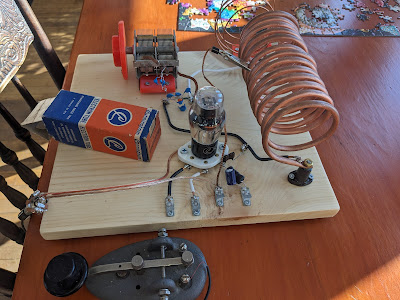New Amateur Satellite, XW-1
I just finished listening to the morse code beacon of a new amateur satellite, XW-1, made by amateurs in China and launched by the Chinese government. This is going to be an excellent communications satellite. It has a 1200 km high orbit, meaning that it sees more of the earth than a lower satellite, and therefore people at a greater distance can talk to each other through it. Also, judging by the beacon, it provides a very steady signal, not terribly subject to fades.
I didn't start hearing the satellite until it was 5 deg. above the horizon according to my tracking program. However, from there on the signal was quite strong. I had one big fade around 5 deg. above setting. But then, the signal continued even after the satellite should have passed behind my horizon! Obviously, the keplerian elements I used:
OBJECT A
1 36121U 09072A 09349.15640464 -.00000045 00000-0 00000+0 0 19
2 36121 100.5046 046.2483 0006436 232.0630 127.9902 13.18995687 00
were a bit off, and the satellite is probably audible roughly horizon-to-horizon. Update 2009-12-20 Don't use these keps. They were off when I posted this, and they are really off now.
This is impressive because I have a very meager receiving system right now, just a 1/4 wave vertical made from house wiring attached directly to a N-connector. That, in turn, connects to a 3m length of LMR-400 coaxial cable, which attaches to a low-noise preamp. With this arrangement, I can hear all the CW beacons I want, even the 80mW ones from the cubesats. According to the AMSAT news service, the beacon of XW-1 is 200mW. The result was a signal that didn't necessarily seem stronger, but rather seemed less subject to fades.
In a situation like this, where we don't know exactly where the satellite is in the sky, an omni-directional antenna like my vertical is really quite a bit more fun than big yagis. A highly directional antenna might well be pointing only 20 deg. off from the bird and therefore receiving nothing. I've had that experience, where I'm trying to manually adjust the antenna array and the doppler-shifted frequency at the same time, looking for two needles in a haystack at the same time, as it were. With an omni, there's less hunting.
That said, the ideal to which I am aiming is to have omni-directional antennas and a highly directional array at the same time, with coaxial switching between them, providing the best of both worlds.
I didn't start hearing the satellite until it was 5 deg. above the horizon according to my tracking program. However, from there on the signal was quite strong. I had one big fade around 5 deg. above setting. But then, the signal continued even after the satellite should have passed behind my horizon! Obviously, the keplerian elements I used:
were a bit off, and the satellite is probably audible roughly horizon-to-horizon. Update 2009-12-20 Don't use these keps. They were off when I posted this, and they are really off now.
This is impressive because I have a very meager receiving system right now, just a 1/4 wave vertical made from house wiring attached directly to a N-connector. That, in turn, connects to a 3m length of LMR-400 coaxial cable, which attaches to a low-noise preamp. With this arrangement, I can hear all the CW beacons I want, even the 80mW ones from the cubesats. According to the AMSAT news service, the beacon of XW-1 is 200mW. The result was a signal that didn't necessarily seem stronger, but rather seemed less subject to fades.
In a situation like this, where we don't know exactly where the satellite is in the sky, an omni-directional antenna like my vertical is really quite a bit more fun than big yagis. A highly directional antenna might well be pointing only 20 deg. off from the bird and therefore receiving nothing. I've had that experience, where I'm trying to manually adjust the antenna array and the doppler-shifted frequency at the same time, looking for two needles in a haystack at the same time, as it were. With an omni, there's less hunting.
That said, the ideal to which I am aiming is to have omni-directional antennas and a highly directional array at the same time, with coaxial switching between them, providing the best of both worlds.


Not heard it yet but didn't know where abouts it was. The Keper Elemnts I got off amsat.org seem to be way off the mark. My equp isn't that good either just a 5 ele AL Special stuck NE. Not planning to operate just want to hear the beacon.
ReplyDeleteThanks for your info, bery useful
73's Frank G4HBI
Frank --
ReplyDeleteThe keps above are about 3 degrees early; it looks to me like the OBJECT A ones that have been floating around amsat-bb are right on the money. You'll want to tune around a bit, since the downlink is not exact either, just go 10 kHz above and below 435.790 MHz, tuning very slowly. I'll add, since you didn't mention it, that a low noise preamp mounted at the antenna is considered required equipment for satellite work. For instance, the above 1/4wave vertical with the preamp works much better than a yagi without, assuming the same feedline and receiver.